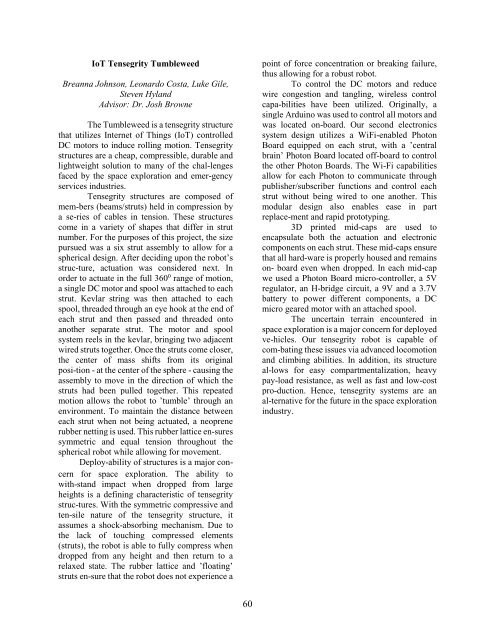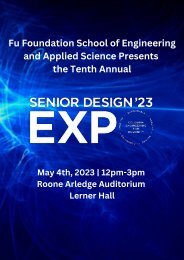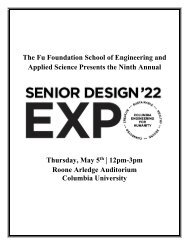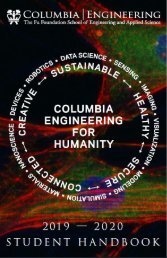Senior Design Expo 2019
The Senior Design Expo, held annually in May at Columbia University, is an opportunity for Columbia Engineering students to showcase what they have learned in their foundational math and science courses together with their engineering courses in innovative, creative, and purposeful designs and prototypes. Each year the Expo showcases more than 60 projects across all nine departments. Projects have included cutting-edge robotics, the New York City subway system, language technology, proposals for bridges to span the Hudson river, and much more.
The Senior Design Expo, held annually in May at Columbia University, is an opportunity for Columbia Engineering students to showcase what they have learned in their foundational math and science courses together with their engineering courses in innovative, creative, and purposeful designs and prototypes. Each year the Expo showcases more than 60 projects across all nine departments. Projects have included cutting-edge robotics, the New York City subway system, language technology, proposals for bridges to span the Hudson river, and much more.
You also want an ePaper? Increase the reach of your titles
YUMPU automatically turns print PDFs into web optimized ePapers that Google loves.
IoT Tensegrity Tumbleweed<br />
Breanna Johnson, Leonardo Costa, Luke Gile,<br />
Steven Hyland<br />
Advisor: Dr. Josh Browne<br />
The Tumbleweed is a tensegrity structure<br />
that utilizes Internet of Things (IoT) controlled<br />
DC motors to induce rolling motion. Tensegrity<br />
structures are a cheap, compressible, durable and<br />
lightweight solution to many of the challenges<br />
faced by the space exploration and emergency<br />
services industries.<br />
Tensegrity structures are composed of<br />
members (beams/struts) held in compression by<br />
a series of cables in tension. These structures<br />
come in a variety of shapes that differ in strut<br />
number. For the purposes of this project, the size<br />
pursued was a six strut assembly to allow for a<br />
spherical design. After deciding upon the robot’s<br />
structure, actuation was considered next. In<br />
order to actuate in the full 360 0 range of motion,<br />
a single DC motor and spool was attached to each<br />
strut. Kevlar string was then attached to each<br />
spool, threaded through an eye hook at the end of<br />
each strut and then passed and threaded onto<br />
another separate strut. The motor and spool<br />
system reels in the kevlar, bringing two adjacent<br />
wired struts together. Once the struts come closer,<br />
the center of mass shifts from its original<br />
position - at the center of the sphere - causing the<br />
assembly to move in the direction of which the<br />
struts had been pulled together. This repeated<br />
motion allows the robot to ’tumble’ through an<br />
environment. To maintain the distance between<br />
each strut when not being actuated, a neoprene<br />
rubber netting is used. This rubber lattice ensures<br />
symmetric and equal tension throughout the<br />
spherical robot while allowing for movement.<br />
Deploy-ability of structures is a major concern<br />
for space exploration. The ability to<br />
withstand impact when dropped from large<br />
heights is a defining characteristic of tensegrity<br />
structures. With the symmetric compressive and<br />
tensile nature of the tensegrity structure, it<br />
assumes a shock-absorbing mechanism. Due to<br />
the lack of touching compressed elements<br />
(struts), the robot is able to fully compress when<br />
dropped from any height and then return to a<br />
relaxed state. The rubber lattice and ’floating’<br />
struts ensure that the robot does not experience a<br />
point of force concentration or breaking failure,<br />
thus allowing for a robust robot.<br />
To control the DC motors and reduce<br />
wire congestion and tangling, wireless control<br />
capabilities have been utilized. Originally, a<br />
single Arduino was used to control all motors and<br />
was located on-board. Our second electronics<br />
system design utilizes a WiFi-enabled Photon<br />
Board equipped on each strut, with a ’central<br />
brain’ Photon Board located off-board to control<br />
the other Photon Boards. The Wi-Fi capabilities<br />
allow for each Photon to communicate through<br />
publisher/subscriber functions and control each<br />
strut without being wired to one another. This<br />
modular design also enables ease in part<br />
replacement and rapid prototyping.<br />
3D printed mid-caps are used to<br />
encapsulate both the actuation and electronic<br />
components on each strut. These mid-caps ensure<br />
that all hardware is properly housed and remains<br />
on- board even when dropped. In each mid-cap<br />
we used a Photon Board micro-controller, a 5V<br />
regulator, an H-bridge circuit, a 9V and a 3.7V<br />
battery to power different components, a DC<br />
micro geared motor with an attached spool.<br />
The uncertain terrain encountered in<br />
space exploration is a major concern for deployed<br />
vehicles. Our tensegrity robot is capable of<br />
combating these issues via advanced locomotion<br />
and climbing abilities. In addition, its structure<br />
allows for easy compartmentalization, heavy<br />
payload resistance, as well as fast and low-cost<br />
production. Hence, tensegrity systems are an<br />
alternative for the future in the space exploration<br />
industry.<br />
60








